ESP Downhole Disc Filter
The downhole disc filter uses metal mesh discs compacted together to form a thick filter element around a pre-perforated basepipe. This innovative approach to sand control dramatically increases filtering capacity while also improving fluid flow through the element.
BENEFITS

Solids are distributed across a greater surface area, trapping more particles without impeding flow

Compressed mesh discs provide greater surface area and higher flow capacity in a shorter assembly
applications
- Hydraulically fractured wells
- ESP protection from sand and proppant 100 μm and larger
- Wells prone to slotted screen plugging
capabilities
- Helps protect downhole pumps during production startup and throughout the ESP’s runlife
- Mesh discs can be cleaned and replaced multiple times, reducing waste
- 433 series (110 mm) available with filtration ratings of 100, 200, 300 and 500 microns
features
- Pre-perforated basepipe offers a strong, reliable base
- Tightly compressed mesh discs form a filter element that delivers superior filtration while enabling fluids to pass
- Bypass protects ESP components from overheating

TECHNICAL CHARACTERISTICS

|
Outer Diameter |
Operating capacity |
Filtration rating |
Solids content |
Length |
|
4.33 in. 110 mm |
190-3,770 bbl/d 30-600 m3/d |
100, 200, 300, 500 mcm |
up to 1050 ptb up to 3000 mg/l |
4.4-22.5 ft 1.3-6.9 m |
Sand and proppant damage ESPs, reduce production, and cost you money
63% of ESP problems are caused by solids. Related production problems include reduced ESP efficiency and runlife as sand erodes system components, declining production rates, equipment failure, and the destruction of impellers and bearings. This all leads to lost production and increased costs.
The most popular solution is not always the best
Slotted screens are the most common sand control technology used because they are simple in design, easy to run with the ESP, have high availability, and are reasonably priced. The problem is that they can become clogged easily with clay and other small particles. In wells where slotted screens are prone to clogging, there hasn’t been a good long-term solution for sand control… until now.
A better sand control solution—the downhole disc filter
The downhole disc filter uses a thick filter element created by stacking and compressing metal mesh discs together around a perforated basepipe.
Greater surface area
The metal mesh discs dramatically increase surface area, which enables the downhole disc filter to handle six to eight times more solids than slotted screens without impeding the flow of reservoir fluids.
Increased ESP runlife
The downhole disc filter can be installed with a sealing unit or just below a motor shroud. Recent installations have shown the downhole disc filter to increase ESP runlife by two to three times (and even more in some instances) while decreasing solids content in produced fluid by two times.
